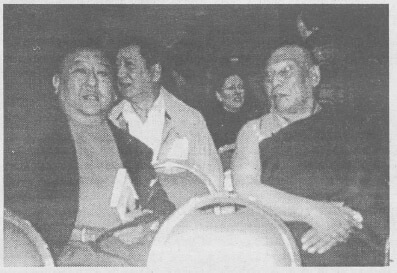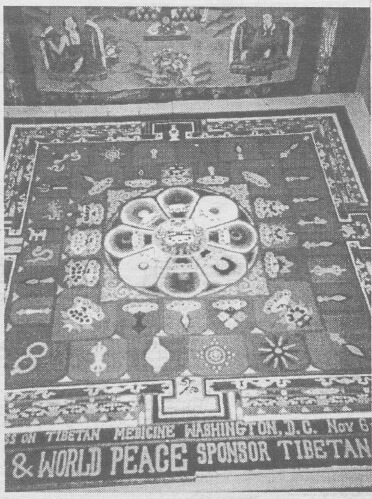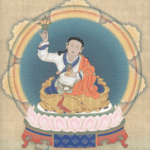| The following article is from the Winter, 2004 issue of the Snow Lion Newsletter and is for historical reference only. You can see this in context of the original newsletter here. |
BY VICTORIA HUCKENPAHLER
Five years have passed since the first International Congress on Tibetan Medicine. In that time, what progress has been made in welcoming Tibetan medicine into the growing family of alternative therapies sought in the West? The question was answered—and for the most part favorably—through the many presentations and panel discussions comprising the Second Congress on Tibetan Medicine, taking place in Washington D.C. November 5-8.
A number of sessions took up the theme of Tibetan spiritual practice in relation to mental health. In Monks in the Lab, Dr. Herbert Benson, pioneer in the study of meditation and its effects on physiological responses, recalled his early experiments among Tibetan yogis, and introduced one such, a Bon-trained monk who participated in Benson's tummo studies. He noted that when there is deep immersion in tummo meditation, metabolism decreases as much as 64%, whereas even during sleep it normally decreases by only 13%. Benson's colleague, Dr. Michael Baime, who directs the University of Pennsylvania's Stress Management Program, is performing equally sophisticated SPECT-scan tests which measure brain activity at isolated moments in time. Converting a hospital closet into a shrine room, Baime measured brain function in meditators before and during the practice of Vajrayogini. The result was measurably increased activity in the parietal lobe, a brain center connected with spatial orientation. This, he said, would explain why deep meditation is often associated with a lost sense of orientation. Baime also noted that the brain area, activated at the height of meditation was not the same as that activated when one experiences conventional emotions such as craving and lust.

Gehlek Rinpoche, left, and Yeshe Dhonden, right, just prior to Tibetan Medicine and Cancer session.
Dr. Margaret Kemeny, a professor of psychiatry at U.C. San Francisco, reported on her work integrating the Buddhist contemplative tradition with Western psychological practice. Choosing fifteen school teachers who committed to a 5-week intensive on how to recognize one's own cognitive distortions, improve listening skills, and develop compassion, Dr. Kemeny discovered participants experienced a sizeable reduction in anxiety and hostility, and a great reduction in depression. Part of her rationale in choosing school teachers was that theirs is a high-stress profession, and that they would hopefully pass along any benefits of the program to their students.

What progress has been made in welcoming t Tibetan medicine into the growing family of alternative therapies sought in the West? The question was answered―and for the most part favorably.
At this point, Dr. Alan Wallace, whose incisiveness and breadth of knowledge had the audience consistently awed, sounded a note of caution by recalling a conversation that had taken place years ago between the Dalai Lama and Jon
Kabat-Zinn of the Stress Reduction Clinic, U. Mass. Medical Center. When Kabat-Zinn described how Buddhist techniques shorn of all spiritual dimension were being used at the clinic, and asked timidly if that was okay, His Holiness replied, Yes, if it's helping people. But don't confuse that with Buddhism!
During another session on Tibetan Medicine and mental health, Dr. Wallace asked the Bon master, Tenzin Wangyal Rinpoche, how Tibetans handle mental disease, given that they don't embrace the Western belief in a psyche. Rinpoche explained that Tibetan society holds a respect for parents, teachers, and elders that is lacking in the West. Hence, when someone like the Dalai Lama gives troubled individuals the advice, Just be happy, whereas those words sound simplistic to the West, they resonate with Tibetans. It's as if they are being furnished with permission to discard dementia or depression by someone they wholly trust.

Above photo: Sand mandala specifically created for the Second Congress on Tibetan Medicine.
At different junctures both Tenzin Wangyal and Chimita Garmayeva, a researcher from Ulan-Ude specializing in the history and ethnography of Tibetan medicine, referred to external forces which, in the Bon-Buddhist worldview, can impact on health. Rinpoche described soul-retrieval rituals and called Bon shamans in some sense environmentalists because they believe that when humans damage the natural elements, the spirits of those elements take revenge by visiting illness on the offenders. Garmayeva elaborated on the specifics, listing the various classes of demons which can enter the internal channels and force out the life-bearing wind energy.
A variety of other panels and activities added to the richness of the conference: a discussion of Tibetan medicine and cancer featured Dr. Yeshi Dhonden, who described the two major kinds of tumors and how the dominant humors can alter their growth rate; Dechen Shak-Dagsay, daughter of Dagsay Tulku, presented a workshop on the healing power of mantras (she has put out a CD of mantras, resonantly intoned); and filmmaker Andy Maleta showed a vivid documentary, soon to be available to the public, on traditional Ladakhi Amchis, including some of the last footage taken of the late Dr. Tenzin Choedrak.
The presence of Gehlek Rinpoche, whose familiarity with English expressions stands in witty contrast to his Tibetan accent, gave spiritual continuity to the conference, imbuing it with a feeling of over-arching blessing. Rinpoche graced many panels, signed copies of his book, Good Life, Good Death (at one point he quipped, I have to believe in reincarnation; I wrote a book about it!), and closed the event with a marathon three- hour teaching on the spirit of the Medicine Buddha. On the specific topic of remedies he proved very moderate, answering a question that has plagued many meditators: Is reliance on medications, especially those used to counteract depression and other mental problems, a betrayal of one's practice? If it's helpful, go for it―whether it's traditionally correct or not, he said, pronouncing himself traditional and conservative, but liberal, too! A chemical imbalance in the body can't be immediately balanced by meditation. That maybe takes years. You can wait till the cows come home, or you can do something now. Use a combination of meditation and medication. I don't personally support some people's idea of stopping medication and replacing it with White Tara!
At the start of the closing ceremonies Rinpoche reminded us of the impending lunar eclipse―an important event in the Tibetan tradition―and invited a colleague to show a slide of the day's unusual configuration of planets, lines drawn connecting them. There was a collective gasp from the audience at the image of two interlaced triangles recalling Vajrayogini's phenomena source (Dharmakara). At exactly 8:16 PM, the moment of full lunar eclipse, Rinpoche led everyone in a heartfelt repetition of the Four Immeasurables, bringing to an auspicious close an event which bodes well for the future of Tibetan medicine in the West.

